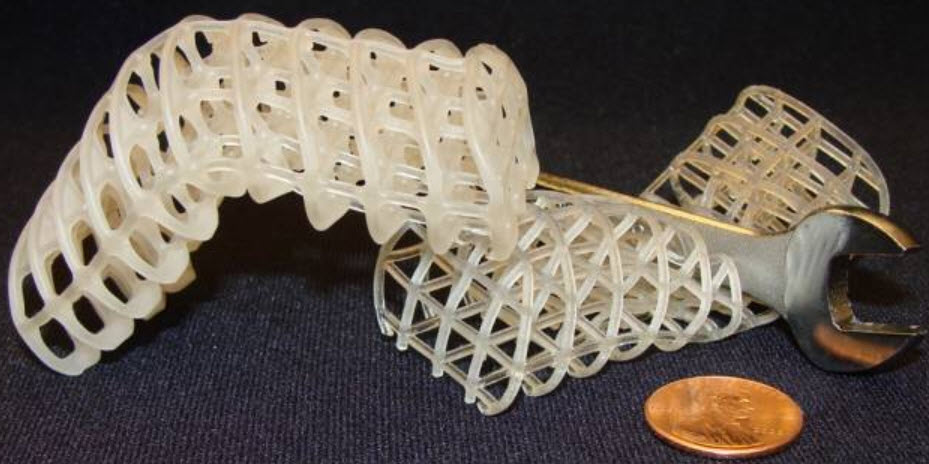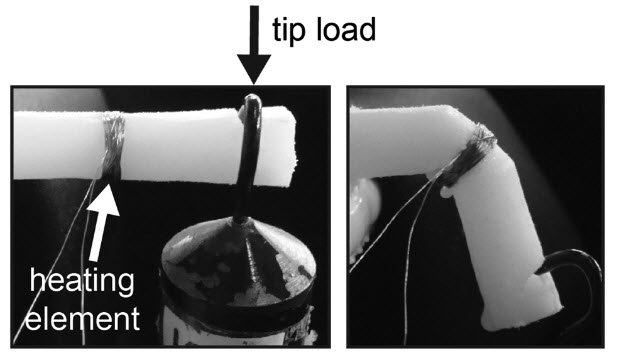Morphing material could allow robots to switch between hard and soft states
July 15, 2014

Two 3D-printed soft, flexible scaffolds: The one on the left is maintained in a rigid, bent position via a cooled, rigid wax coating, while the one on the right is uncoated and remains compliant (here, it collapses under a wrench). (Credit: Nadia G. Cheng et al.)
A new Terminator T-1000 robot-style material made of wax and foam — and capable of switching between hard and soft states — could be used to build morphing surgical robots that move through the body to reach a desired location without damaging organs or vessels along the way.
Robots built from the material, described in a new paper in the journal Macromolecular Materials and Engineering, could also be used in search-and-rescue operations to squeeze through rubble looking for survivors, says Anette Hosoi, an MIT professor of mechanical engineering and applied mathematics who led the research team.
MIT is working on the project with robotics company Boston Dynamics, who began developing the material as part of DARPA’s Chemical Robots program, the Max Planck Institute for Dynamics and Self-Organization, and Stony Brook University.
Squishy robots

A wax-filled, open-cell polyurethane foam beam (diameter 10 mm) used as an articulated joint. Copper wire wound around the perimeter of the beam is used as a resistive heating element to locally control the temperature of the wax. Left: The rigid beam at room temperature; right: after 3.3 W of power was applied to the heating element for 70 s. The wax melts and causes the beam to bend due to applied tip load (100 g). (Credit: Nadia G. Cheng et al./Macromolecular Materials and Engineering)
Controlling a very soft structure is difficult, compared to a rigid robot. It’s much harder to predict how the material will move and what shapes it will form. So the researchers decided to develop a material that can switch between a soft and hard state by coating a foam structure in wax. (Foam can be squeezed into a small fraction of its normal size, but once released will bounce back to its original shape.)
The wax coating, meanwhile, can change from a hard outer shell to a soft, pliable surface with moderate heating. This could be done by running a wire along each of the coated foam struts and then applying a current to heat up and melt the surrounding wax. Turning off the current again would allow the material to cool down and return to its rigid state.
In addition to switching the material to its soft state, heating the wax in this way would also repair any damage sustained, Hosoi says. “This material is self-healing,” she says. “So if you push it too far and fracture the coating, you can heat it and then cool it, and the structure returns to its original configuration.”
To build the material, the researchers simply placed the polyurethane foam in a bath of melted wax.
They also found that a 3D-printed lattice worked better than the polyurethane foam, which would still be fine for low-cost applications, Hosoi says. The wax coating could also be replaced by a stronger material, such as solder, she adds.
Hosoi is now investigating the use of other unconventional materials for robotics, such as magnetorheological and electrorheological fluids. These materials consist of a liquid with particles suspended inside, and can be made to switch from a soft to a rigid state with the application of a magnetic or electric field.
MIT | A new phase-changing material built from wax and foam developed by MIT researchers is capable of switching between hard and soft states.
Abstract of Macromolecular Materials and Engineering paper
The field of soft robotics has inspired recent mechanical engineering and materials science innovations to enable shape-shifting systems to be developed. This paper presents the design and analysis of a novel thermally tunable composite, namely, a flexible open-cell foam coated in wax that can achieve significant ranges of stiffness, strength, and volume. Experimental results were compared to a proposed model for predicting the bulk compression modulus of the composites. Additionally, preliminary studies indicate that the composites exhibit self-healing properties, in which heating between loading cycles can mend wax that has been plastically deformed, for example, by cracking or delaminating from the foam.